Recipes and Preparation
You'll Never Guess the Simple Trick to Perfectly Cleaning Foraged Mussels
Uncover the surprising 'O' trick for flawlessly cleaning foraged mussels, ensuring a delectable meal awaits – discover more culinary secrets!

To ensure perfectly cleaned foraged mussels, begin by immersing them in cold water for 30 minutes to get rid of any grit and debris. Next, grab the beard and pull it towards the shell’s hinge, carefully detach them from rocks, and rub the shells together to remove any barnacles for a smoother cooking experience. Remember to inspect, debeard, and scrub the mussels before cooking to ensure a delicious and safe meal. This thorough process guarantees a delightful culinary adventure. Discover additional culinary tips to elevate your seafood dishes and relish in the harmonious flavors that await you.
Key Takeaways
- Soak foraged mussels in cold water to remove grit and debris.
- Carefully remove the beard by pulling towards the shell's hinge.
- Gently detach mussels from rocks and rub shells to eliminate barnacles.
- Inspect, debeard, and scrub mussels thoroughly before cooking.
- Ensure mussels are safe by testing for toxins and following local regulations.
Soaking Mussels in Water
To effectively clean foraged mussels, begin by soaking them in cold water for approximately 30 minutes to purge sand and debris. Soaking mussels in water is an essential step in preparing these delectable shellfish for cooking. Not only does this process help rid the mussels of any unwanted grit, but it also aids in plumping them up, ensuring a more succulent final dish.
The recommended 30-minute soak in cold water not only maintains the freshness of the mussels but also plays a significant role in enhancing their flavor. As the mussels sit in the water, they naturally expel any sand or debris they may have accumulated, resulting in a cleaner and more enjoyable dining experience.
Removing the Beard
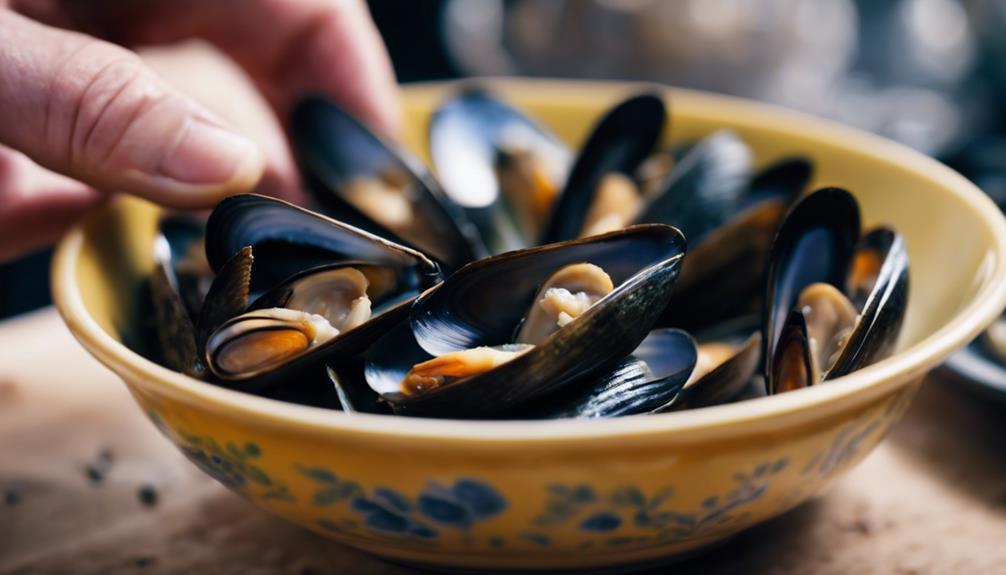
Start by firmly grasping the beard of the mussel between your thumb and forefinger to remove it. The beard, a fibrous strand that helps the mussel attach to rocks, can be easily taken off by pulling it towards the shell's hinge. To make the process smoother, consider soaking the mussels in salt water before tackling the beards.
Here are some tips to guide you through this task:
- Gently but firmly tug the beard to avoid breaking it.
- Keep a steady hand to prevent the beard from slipping out of your grasp.
- Be patient; some beards may be more stubborn to remove than others.
- Enjoy the satisfaction of cleanly removing the beard, revealing the mussel's pristine shell.
- Remember that a clean mussel without its beard is one step closer to a delicious meal.
Detaching From Rocks
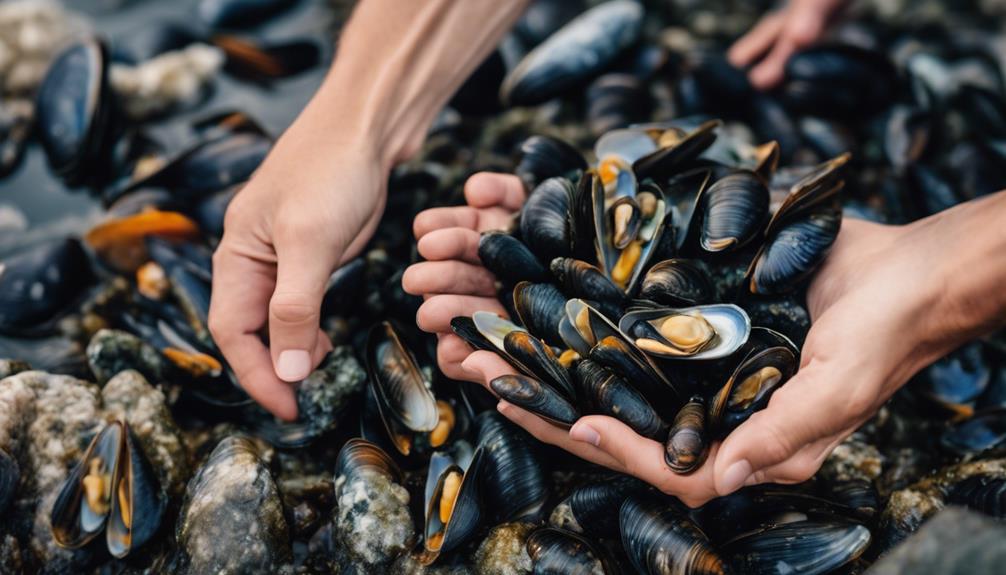
To detach mussels from rocks, gently pull on the beard protruding from the shell. This fibrous thread is how mussels anchor themselves to surfaces like rocks.
Rock Detachment Tools
Using a mussel knife or a sharp tool gently insert between the mussel's shell and the rock to detach it effectively. Rock detachment tools are essential for safely harvesting mussels.
Here are five emotional aspects to keep in mind while using these tools:
- Respect: Treat the mussels and their environment with care.
- Precision: Guarantee accurate placement of the tool to avoid damaging the delicate shells.
- Connection: Feel the satisfying moment when the mussel releases from the rock.
- Appreciation: Recognize the effort required to detach mussels without causing harm.
- Responsibility: Take pride in using the correct techniques to safeguard both the mussels and the ecosystem.
Gentle Twisting Technique
Effortlessly detach mussels from rocks by employing the gentle twisting technique to break the byssal threads.
When foraging for mussels, it's important to delicately twist them to separate them from their rocky homes. Byssal threads, the protein fibers mussels use to cling to surfaces, require a gentle touch to release the shellfish unharmed.
To master this technique, gently twist the mussels with a subtle back-and-forth motion to detach them smoothly. This method guarantees the mussels are freed from the rocks without causing damage to their shells or the mussel itself.
By utilizing the twisting technique, you can easily remove mussels from their rocky perches, preparing them for the subsequent cleaning and cooking processes.
Safety Precautions Foragers
Guarantee your safety while detaching mussels from rocks by following these essential precautions:
- Always face the ocean: Guarantee you have a clear view of the water to react quickly to any changes in the environment.
- Beware of large swells: Avoid turning your back on the ocean, especially during big waves, to prevent being caught off guard.
- Harvest a manageable amount: Limit your collection to around 30 clean mussels to maintain control and prevent overwhelming yourself.
- Check environmental conditions: Choose a calm water area for easier harvesting and to reduce risks associated with rough seas.
- Stay aware of your surroundings: Keep an eye out for slippery rocks, sharp edges, and other hazards that could lead to accidents.
Rubbing to Eliminate Barnacles
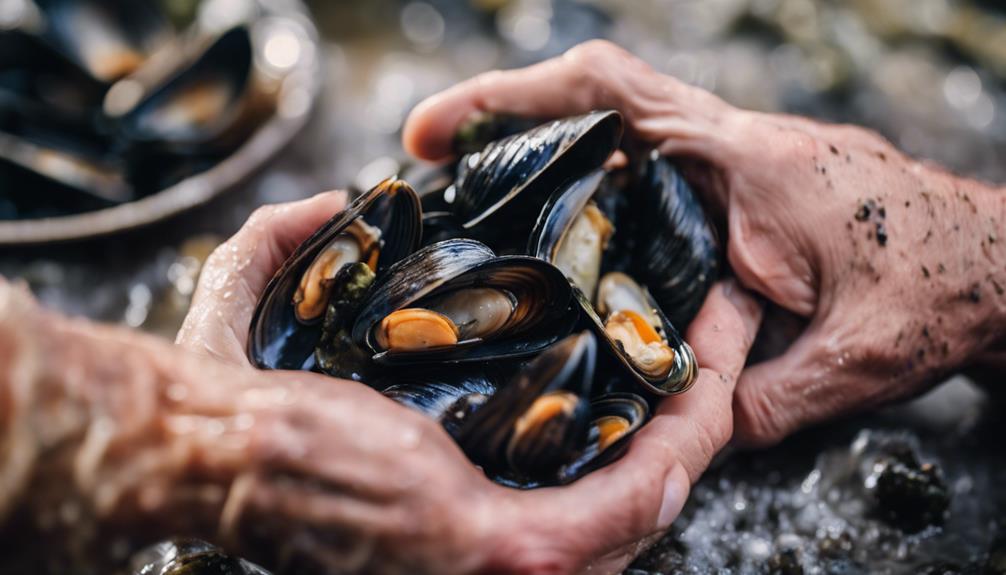
For effective barnacle removal from foraged mussels, vigorously rub the shells together to dislodge any attached small barnacles. By creating friction between the shells, you can effectively remove these unwanted hitchhikers. The rubbing motion helps loosen the barnacles, making them easier to be detached. This step is important in guaranteeing a smooth cooking process and enhancing the overall presentation of your mussels.
When rubbing the mussels, pay special attention to areas where small barnacles are clustered. These spots tend to harbor more barnacles, so focusing on them will ensure a thorough cleaning process.
Enhancing Flavor With Cleaning

Enhancing the flavor of your foraged mussels starts with thorough cleaning to remove sand and barnacles, ensuring a delightful culinary experience.
- Rinse with Care: Gently rinse mussels under cold water to maintain their delicate flavor profile.
- Inspect Closely: Take the time to inspect each mussel, ensuring they're free from any visible debris.
- Debeard with Precision: Properly debeard mussels to eliminate any unwanted textures while cooking.
- Scrub Thoughtfully: Use a brush to scrub mussels, guaranteeing a clean and appetizing final dish.
- Enjoy the Process: Embrace the cleaning process as part of the journey to savoring delicious foraged mussels.
Ensuring Safety and Quality

Prioritize safety and quality when foraging mussels by following essential guidelines and precautions. Before heading out, check for red tide warnings and consult local authorities for shellfish safety guidelines to avoid harmful toxins.
To make certain the mussels you gather are safe to consume, use caution when testing for toxins by rubbing them on your lips and watching for symptoms of paralytic shellfish poisoning.
It's imperative to harvest mussels responsibly by handpicking them to minimize damage to mussel beds and reduce environmental impact. Opt for harvesting in clear, calm water conditions and target mussels from high intertidal zones for easier and safer collection.
Freeing Mussels From Debris

To guarantee mussels are free from debris effectively, start by scrubbing them to remove barnacles and seaweed, then rinse under cold water for a thorough clean.
Next, focus on removing sand and grit by soaking the mussels in cold water with a touch of flour to help expel any unwanted particles.
This process secures that your mussels are clean and ready to enhance the flavors of your dish, providing a delightful dining experience.
Removing Sand and Grit
Start by soaking the wild mussels in cold water for 30 minutes to allow them to filter out sand and grit. This step is important to make sure your mussels are free from any unwanted debris that may affect the taste and texture of your dish.
Here are a few tips to help you effectively remove sand and grit from your foraged mussels:
- Be Patient: Letting the mussels sit in water gives them time to expel any sand or grit they may have inside.
- Handle with Care: Avoid agitating the water too much, as this can cause the mussels to re-ingest the sand they've already filtered out.
- Stay Observant: Keep an eye out for any mussels that aren't tightly closed or that float, as these may not be safe to eat.
- Embrace the Process: Cleaning mussels can be a therapeutic activity, connecting you with the food you're preparing.
- Enjoy the Fruits of Your Labor: The effort you put into cleaning your foraged mussels will pay off in a delicious and satisfying meal.
Rinsing Under Water
Begin by rinsing the foraged mussels under cold running water to effectively free them from any sand, dirt, or debris clinging to their shells. Rinsing under water is an important step in preparing mussels for cooking.
As you rinse, gently scrub each mussel with a brush or your fingers to make sure the exterior is thoroughly cleaned. Take this opportunity to inspect the mussels closely, checking for any cracked or open shells that should be discarded.
To facilitate the rinsing process, use a colander or a large bowl, allowing the water to flow through and carry away any impurities. This thorough rinsing not only removes unwanted particles but also helps guarantee a clean and safe final dish.
Prepping for Cooking Process

Before cooking your foraged mussels, make sure you have soaked them in cold water for 30 minutes to eliminate sand and debris, scrubbed off barnacles, removed the beard, and checked for live mussels by tapping open shells.
To make certain your mussels are prepped perfectly for cooking, consider the following:
- Gently Clean: Taking the time to scrub off any barnacles and remove the beard guarantees you're starting with clean mussels.
- Check for Freshness: Tapping open shells and discarding any cracked ones will help you identify live mussels, ensuring they're safe to eat.
- Proper Storage: Storing mussels in the refrigerator on a damp towel can keep them fresh for a couple of days before you cook them.
- Restaurant Tricks: Restaurants often store mussels on a perforated tray over ice to maintain their quality and freshness.
- Be Thorough: Don't rush the prepping process; thorough cleaning and checking will guarantee a delicious final dish.
Enjoying the Flavors of the Sea
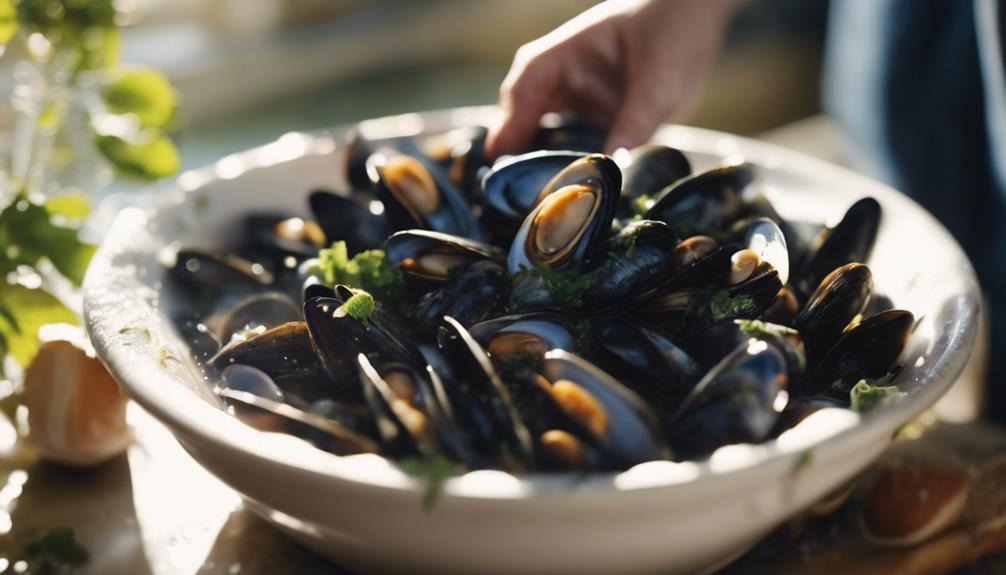
To fully savor the flavors of the sea, initiate your foraged mussels with a combination of olive oil, garlic, and canned tomatoes in your cooking process. This trio of ingredients creates a rich and savory base that complements the natural brininess of the mussels. For an authentic coastal taste, consider adding a touch of ocean water or beer to the cooking pan. These ingredients infuse the mussels with a unique depth of flavor that transports you to the seaside.
Once your mussels are cooked to perfection, top them with freshly chopped parsley and pair them with artichoke bread. The combination of tender mussels, fragrant herbs, and crusty bread creates a delightful harmony of textures and tastes. To add a zesty kick, squeeze fresh lemon juice over the mussels for a burst of citrus flavor.
As you enjoy your dish, don't forget to dip the artichoke bread into the savory mussel sauce. This simple act enhances each bite, allowing you to fully appreciate the flavors of the sea. Whether you're a seasoned seafood enthusiast or a newcomer to foraged mussels, this culinary experience is sure to delight your taste buds.
Achieving Peace of Mind

Achieving peace of mind while foraging for mussels involves comprehending local regulations and safety guidelines to guarantee a worry-free experience.
To really guarantee a stress-free outing, consider the following:
- Know Your Regulations: Familiarize yourself with local laws to avoid any legal concerns.
- Identify Safe Mussels: Learning how to spot healthy mussels can prevent any health risks.
- Test for Toxins: Conducting tests for toxins assures the mussels are safe for consumption.
- Proper Cleaning Methods: Thoroughly clean and prepare the mussels before cooking to enjoy a worry-free meal.
- Environmental Awareness: Stay informed about water conditions, algae blooms, and the impact of your harvesting to protect both yourself and the environment.
Frequently Asked Questions
How to Clean Foraged Mussels?
To clean foraged mussels, soak them in cold water, scrub off barnacles, remove the beard, and discard cracked shells. Store in the fridge with a damp towel. Before cooking, strain the mussel liquor to enhance flavor.
How Do You Purge Wild Caught Mussels?
To purge wild caught mussels, soak them in cold water for 30 minutes. This process filters out sand and debris, expelling any grit they ingested. Discard any mussels that float as they may be dead. Enhance flavor and quality by purging mussels.
How Do You Clean Barnacles off Mussels?
To clean barnacles off mussels, scrub them with a brush or knife under running water. Removing barnacles improves appearance and prevents grit in your dish. Clean mussels make for a visually appealing and delicious final meal.
How Do You Clean Mussels Without a Brush?
To clean mussels without a brush, soak them in cold water for 30 minutes to filter out sand and debris effectively. Gently tap to check if they're alive, then scrub off barnacles under running water. Pull the beard towards the hinge to remove easily.
Conclusion
Now that you know the simple trick to perfectly cleaning foraged mussels, you can enjoy the flavors of the sea with ease.
Soaking, removing the beard, detaching from rocks, and rubbing away barnacles are all essential steps to achieving delicious results.
Are you ready to elevate your seafood game and savor the taste of freshly cleaned mussels?
Recipes and Preparation
The Essential Tips for Properly Storing Your Foraging Finds
Take control of your foraging finds with these essential tips for storage – ensure freshness and longevity with expert advice.

To ensure your foraging discoveries are stored properly, place them in a cool, dry area away from direct sunlight to prevent spoiling. Remember to label and date your items for easy tracking of freshness and safe usage. Utilize airtight containers or vacuum-sealed bags for long-lasting preservation. For certain items, consider either freezing or drying them to prolong their shelf life. Managing moisture is crucial; use net wrap and elevate bales to prevent mold growth. Proper compression of bales and spacing of stacks help maintain airflow for quality preservation. Make sure to raise items off the ground to encourage air circulation and prevent moisture buildup. Safeguard the quality and nutrients by shielding against exposure to air and moisture.
Key Takeaways
- Store foraged items in a cool, dry place away from direct sunlight.
- Use airtight containers or vacuum-sealed bags for preservation.
- Label and date items for tracking freshness and safe consumption.
- Consider freezing or drying certain foraged items for long-term storage.
- Avoid high humidity or fluctuating temperatures to prevent spoilage.
Location Considerations

To properly store your foraging finds, begin by considering the essential location for preservation. Store your foraged items in a cool, dry place away from direct sunlight. This will help maintain their freshness and quality over time.
Avoid areas with high humidity or fluctuating temperatures, as these conditions can lead to spoilage. Properly labeling and dating your foraged items is vital to track freshness and guarantee safe consumption.
Utilize airtight containers or vacuum-sealed bags to preserve the flavors and nutrients of your foraged foods effectively. Additionally, for long-term storage and extended enjoyment, consider freezing or drying certain foraged items.
Moisture Control Techniques

Consider implementing moisture control techniques to safeguard your foraging finds from spoilage and nutrient loss. Proper moisture management is crucial for preserving the quality of your edible plants. Excess moisture can lead to mold growth, nutrient degradation, and overall deterioration of your forage.
To combat this, utilize net wrap to shield bales from moisture absorption, and remember to elevate them off the ground to prevent water damage. Confirm there's proper airflow in your storage area, as well as adequate sunlight exposure, as these factors can help reduce moisture levels in your stored forage.
Sunlight Exposure Strategies

Maximize the benefits of sunlight exposure by strategically positioning your foraged items to prevent moisture buildup and mold growth. Placing your foraged finds in direct sunlight aids in drying out freshly harvested plants and fungi, ultimately extending their shelf life.
Sunlight exposure not only helps preserve these items for longer periods but also plays a vital role in maintaining their nutritional value. It's essential to avoid storing your foraged items in shaded areas as this can promote the growth of harmful bacteria.
Proper Bale Density

To guarantee proper bale density for your forage storage, mastering bale compression techniques is essential. By compacting the bales effectively, you optimize storage space and reduce the risk of spoilage.
Maintaining the right balance in bale density will enhance airflow within your storage area, ultimately preserving the quality of your forage.
Bale Compression Techniques
Properly compressing bales guarantees the best preservation of stored forage by reducing air pockets and moisture retention. When it comes to bale compression techniques, achieving the right density is essential for maintaining the quality of your forage. By tightly packing the forage material, you can prevent mold growth and make sure that the forage remains edible and safe for consumption by animals. Utilizing equipment designed for bale compression helps in achieving ideal density, which in turn enhances storage efficiency and minimizes the risks of spoilage. Properly compressed bales not only prolong the longevity of forage but also help retain its nutritional value for animal consumption.
To better understand the importance of bale compression techniques, let's take a look at the following table that highlights the key benefits of achieving the right bale density:
| Benefits of Proper Bale Compression |
|---|
| Reduces air pockets |
| Prevents moisture retention |
| Minimizes mold growth |
| Enhances forage quality |
| Maximizes storage space utilization |
Storage Space Optimization
Effectively compacting bales is essential for optimizing storage space and minimizing losses during forage storage. Proper bale density plays a pivotal role in maximizing storage capacity while preserving forage quality.
Here's how you can achieve the best bale density for storage space optimization:
- Reduce Air Pockets: Increasing bale density helps to eliminate air pockets within the bales, reducing the risk of spoilage due to oxygen exposure.
- Prevent Moisture Absorption: Compact bales are less prone to moisture absorption, maintaining the forage's nutritional value and preventing mold growth.
- Enhance Storage Efficiency: Dense bales are more resistant to compression forces, ensuring they retain their shape and occupy storage space efficiently.
Stack Spacing Importance

Maintaining proper stack spacing between forage bales is essential for preventing moisture buildup and spoilage. When you guarantee adequate spacing, you facilitate essential air circulation, reducing the risk of mold and heat accumulation within the stored bales.
Proper Stack Spacing
Why is stack spacing so essential when storing your foraging finds? Proper stack spacing plays a significant role in preserving the quality of your foraged items. Here's why it matters:
- Preventing Moisture Buildup:
Adequate space between stacks allows for air circulation, reducing the risk of spoilage by preventing condensation.
- Promoting Drying:
Maintaining a distance of at least 3 feet between stacks helps promote drying and prevents items from sticking together, which can trap moisture and lead to mold growth.
- Preserving Quality:
Incorrect stack spacing can compromise the freshness and integrity of your foraged finds. Effective spacing practices are essential for ensuring that your items remain in top condition for longer periods.
Prevent Moisture Buildup
To prevent moisture buildup in your foraging finds, ensuring proper stack spacing is key for maintaining their quality and freshness. By leaving sufficient space between stacked items, you can minimize the risk of mold growth and spoilage, ultimately preserving the integrity of your treasures. Effective stack spacing facilitates air circulation, which is essential in preventing moisture buildup within tightly packed items. This simple yet crucial step can significantly extend the lifespan of your foraged items, allowing you to enjoy them for longer periods while retaining their nutritional value.
| Importance of Proper Stack Spacing |
|---|
| Prevents moisture buildup |
| Reduces risk of mold growth |
| Maintains quality and freshness |
| Preserves nutritional value |
Ensure Air Circulation
Proper air circulation between your foraged items is essential for preserving their quality and preventing moisture buildup, ensuring their longevity and freshness.
When it comes to stack spacing, here's what you need to keep in mind:
- Maintain Adequate Space: Proper stack spacing is critical for allowing air to circulate freely between your foraged finds. Adequate airflow helps prevent moisture buildup, reducing the risk of mold growth and spoilage.
- Avoid Overcrowding: Stacking items too closely together can hinder air circulation, potentially leading to the degradation of your foraged treasures. Leave enough space between stacked items to ensure ideal airflow and maintain ideal storage conditions.
- Preserve Quality: Adequate stack spacing not only helps prevent moisture-related issues but also plays an essential role in preserving the overall quality and freshness of your foraged items for extended periods. By paying attention to stack spacing, you can enhance the longevity of your finds and enjoy them at their best.
Ground Elevation Practices

How can you effectively elevate your foraged items to enhance storage conditions and prevent spoilage?
Elevating your foraged items off the ground is essential in maintaining their quality. By preventing direct contact with the ground, you reduce the risk of moisture absorption, mold growth, and contamination. Storing bales on racks, shelves, or pallets promotes better air circulation around the items, aiding in their preservation. This practice not only helps in preventing spoilage but also extends the freshness of your foraged goods.
Proper ground elevation is vital for creating a dry and ideal storage space. By keeping your foraged items elevated, you enhance air circulation, which is key to preserving their quality. Avoiding direct contact with the ground reduces the chances of spoilage, ensuring that your foraged finds remain in excellent condition for a longer period.
Airflow Maximization Methods

Elevating your foraged items off the ground promotes ideal airflow to prevent moisture absorption and maintain freshness. To maximize airflow and reduce the risk of spoilage due to high moisture levels, follow these essential methods:
- Utilize wood pallets: Stack your foraged items on wood pallets to allow air circulation beneath them. This method helps prevent moisture buildup and keeps your finds fresh for longer periods.
- Alternate bale orientation: When stacking bales, consider alternating their orientation. This practice improves ventilation and airflow between the items, reducing the chances of mold formation.
- Maintain proper spacing: Adequate spacing between bales in storage areas is vital for promoting airflow. By ensuring there's enough room between each item, you can prevent spoilage and maintain the quality of your foraged finds.
Longevity and Nutrition Preservation

To maintain the longevity and nutritional value of your foraged finds, storing them in a cool, dry place away from sunlight is essential. When it comes to edible berries and other foraged items, proper storage is vital for preserving their freshness and nutritional content.
By keeping them in a cool and dry environment, you can help retain their quality for a longer period. Utilizing airtight containers or freezer bags is a practical way to prevent moisture and air exposure, which can lead to spoilage.
Labeling and dating your foraged items will allow you to track their freshness and make certain they're consumed before any degradation occurs. Additionally, vacuum sealing foraged foods can provide an extra layer of protection, safeguarding them against deterioration and maintaining their overall quality over time.
Frequently Asked Questions
How to Store Foraged Goods?
To store foraged goods, keep them in a cool, dry spot. Use breathable containers like paper or mesh bags. Avoid sunlight. Label and date items for freshness. Freeze or preserve for later enjoyment. These steps guarantee ideal storage.
What Are the 9 Rules to Follow When Finding Edible Plants?
When finding edible plants, remember to always positively identify them first. Carry a guidebook for help and utilize the Universal Edibility Test in survival situations. Avoid eating unidentified mushrooms to prevent poisoning.
What Is the Golden Rule of Foraging?
To forage safely, always remember the golden rule: positively identify plants before eating to avoid danger. Proper identification is key for a successful foraging experience. Consult experts or references to guarantee safe foraging.
What to Avoid When Foraging?
When foraging, avoid polluted areas, dog parks, and busy roads to prevent contamination. Refrain from picking plants with strong odors or leaves in groups of three, as they might be toxic. Stay away from toxic ornamental plants and seek expert guidance for safety.
Conclusion
To guarantee proper storage of your foraging finds is essential to maintain their freshness and nutrition. Remember to take into account location, moisture control, sunlight exposure, bale density, stack spacing, ground elevation, airflow, and preservation techniques.
By following these tips, you can make certain your foraged treasures last longer and remain full of flavor. So, next time you gather your wild edibles, give them the care they deserve to enjoy them to the fullest!
Recipes and Preparation
Rat Owners Swear By These Fun and Enriching Foraging Toys
Journey into the world of foraging toys for rats and discover the key to unlocking endless fun and enrichment for your furry friends.
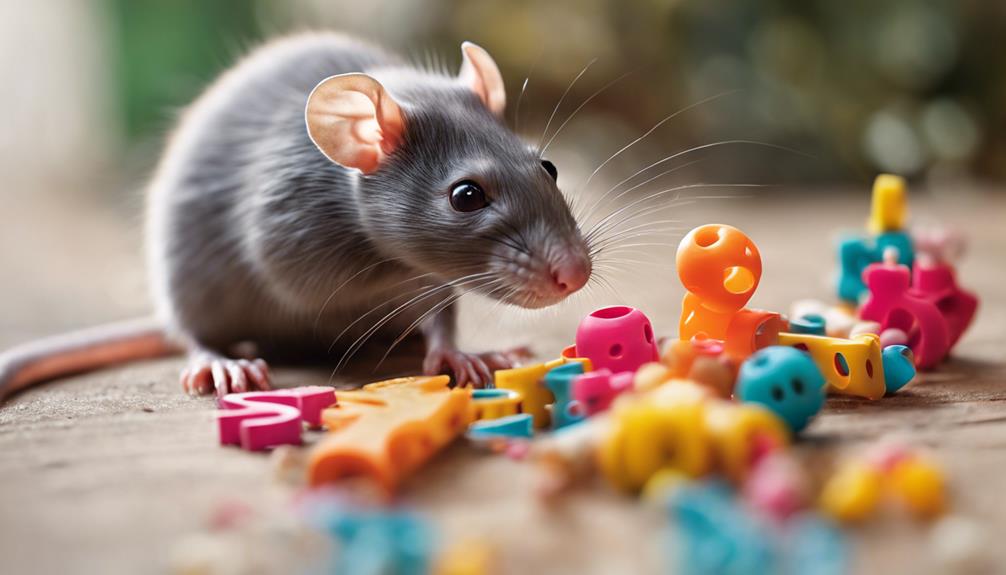
Rat owners, these foraging toys such as the Burrow Box, Celebration Cake, and Garden Dig Box are crucial for keeping your furry friends mentally stimulated and engaged during playtime. The Pyramid Treat Hanger and Run & Hide provide both challenges and safe spaces for your beloved pets. Consider DIY options like the Hideaway Hive for a personalized touch. Multi-species toys like the Bamboo Play Pouch and Rolly Teaser are suitable for a variety of small pets. These toys encourage natural behaviors and contribute to the overall well-being of your rats. Dive into the world of foraging toys that bring happiness and enrichment to your rat’s life.
Key Takeaways
- Burrow Box engages rats in rewarding play and stimulates foraging instincts.
- Celebration Cake offers interactive chewing experience and mental stimulation.
- Garden Dig Box provides physical and mental stimulation with various textures and colors.
- Pyramid Treat Hanger challenges rats to work for treats and encourages natural behaviors.
- Run & Hide toy promotes active foraging play and prevents destructive chewing behaviors.
Burrow Box
Engage your rats' natural foraging instincts with the interactive Burrow Box toy. Designed to provide mental stimulation and promote rat enrichment, this toy is a must-have for your furry friends.
The Burrow Box encourages your rats to use their keen sense of smell to find hidden yummy treats, engaging them in rewarding play sessions.
By offering a variety of treats within the Burrow Box, you can keep your rats entertained for hours while also giving them a great workout. This foraging toy not only satisfies their instinctual behaviors but also helps in keeping them mentally and physically active.
As your rats explore, play, and hide within the Burrow Box, they're engaging in natural behaviors that are essential for their well-being.
Celebration Cake
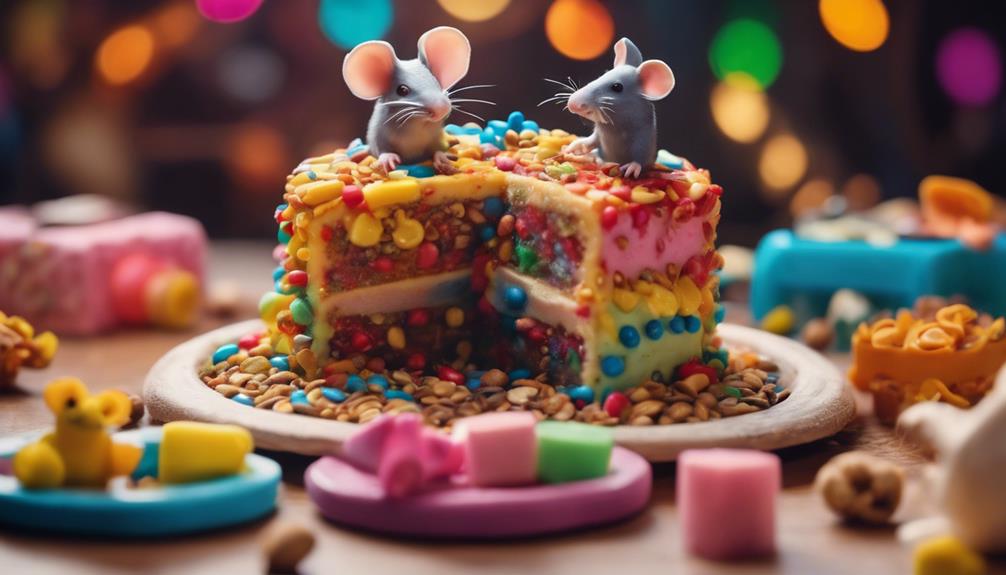
The Celebration Cake for rats offers a delightful and enriching activity for your furry companions. This special rat toy is designed to cater to their chewing behaviors while also providing a fun and interactive experience. By filling the Celebration Cake with treats, you can enhance your rat's enjoyment and stimulate their foraging instincts.
The cake's unique design not only shows your love and care for your pet rats but also encourages them to engage in natural chewing behaviors, promoting mental and physical stimulation.
Rats are known to enjoy exploring and interacting with accessories in their environment, and the Celebration Cake serves as a cute addition to their play area. This foraging toy not only keeps your rats entertained but also helps in keeping their teeth healthy through regular chewing.
Garden Dig Box
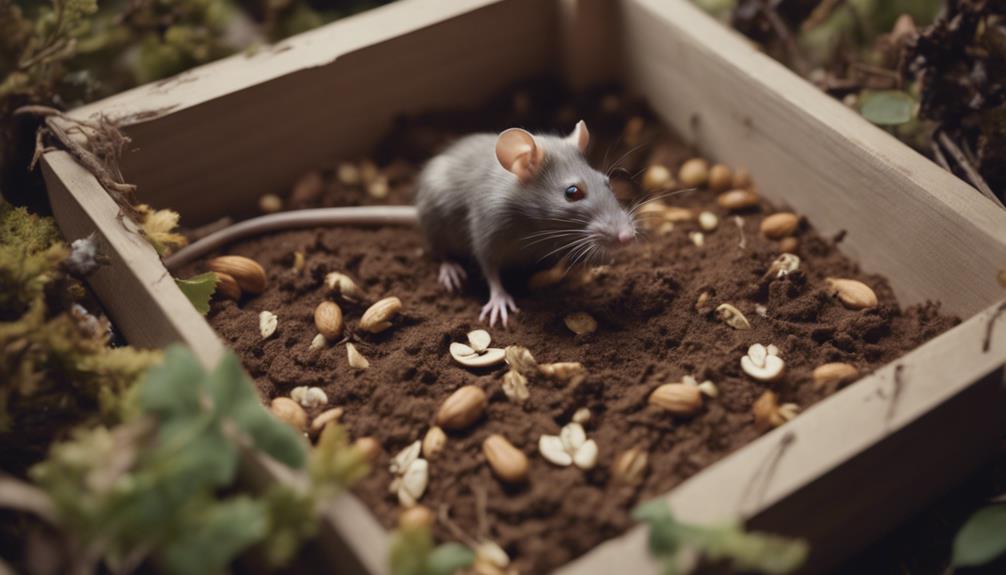
Encouraging rats to explore, play, and chew, the Garden Dig Box is a foraging toy designed to provide mental and physical stimulation. This toy offers various colors and textures for rats to engage with, enhancing their natural behaviors. By filling the box with treats, you can provide hours of rewarding play for your rat, stimulating their senses and promoting their overall well-being in a fun and enriching way.
To give you a better idea of the Garden Dig Box's features, here is a table outlining its key characteristics:
| Feature | Description |
|---|---|
| Design | Foraging toy designed to encourage exploration, play, and chewing |
| Stimulation | Provides mental and physical stimulation through foraging activities |
| Colors and Textures | Offers various engaging colors and textures for enhanced interaction |
| Treat Filling | Can be filled with treats to provide rewarding playtime for your rat |
| Overall Well-being | Stimulates senses and promotes well-being in a fun and enriching manner |
The Garden Dig Box is a fantastic addition to your rat's toy collection, ensuring they stay mentally stimulated and entertained.
Pyramid Treat Hanger
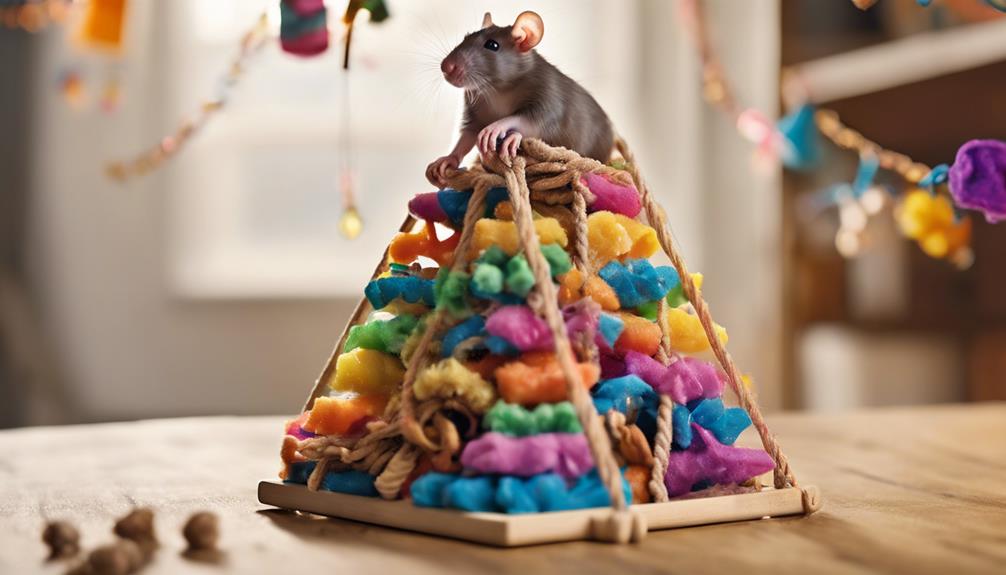
How does the Pyramid Treat Hanger enhance your rat's foraging experience?
The Pyramid Treat Hanger is a fantastic foraging toy that provides your rats with an enriching and mentally stimulating activity. Designed to challenge your rats to work for treats, this toy encourages natural behaviors like chewing, playing, and exploring.
By incorporating enriching materials, such as hidden treats or food, the Pyramid Treat Hanger keeps your rats engaged and mentally stimulated. It offers a fun and interactive way for your rats to enjoy treats while promoting physical and mental activity.
This versatile toy not only helps in keeping your rats entertained but also provides them with a sense of accomplishment as they work to retrieve their rewards. The Pyramid Treat Hanger is a great addition to your rat's environment, offering a fun and enriching foraging experience that will keep them happy and healthy.
Run & Hide

The Run & Hide toy offers rats the opportunity to engage in a fun game of hide and seek, providing them with both physical and mental stimulation.
This toy encourages active foraging play, allowing rats to utilize their natural instincts while having a blast.
Through movement and exploration, the Run & Hide toy enriches the lives of pet rats by offering a dynamic and engaging experience.
Hide & Seek Benefits
In the Run & Hide foraging toy, rats find a safe haven for play and relaxation. The hideout within this toy offers a cozy spot for your pet to feel secure, encouraging natural behaviors like hiding and exploring.
Here are some benefits of the Hide & Seek feature:
- Safety: The hideout in the toy provides a secure environment for your rat to retreat to when feeling stressed or overwhelmed, promoting a sense of safety and well-being.
- Exploration: Rats enjoy the thrill of seeking out the hidden space within the toy, stimulating their curiosity and encouraging them to engage in exploratory behaviors.
- Comfort: The cozy hideout offers a comfortable spot for your rat to rest and relax, providing a peaceful retreat within their play area.
With the Run & Hide foraging toy, your rat can experience mental stimulation, physical activity, and a sense of security, all contributing to their overall enrichment and happiness.
Active Foraging Play
Experience the engaging and stimulating Active Foraging Play with the Run & Hide foraging toy, designed to promote exploration and natural behaviors in pet rats.
This well-made toy is sure to keep your adorable animals entertained for hours while encouraging them to exercise and engage in their instinctual foraging tendencies.
The Run & Hide toy not only provides mental and physical stimulation but also offers a safe space for your rats to retreat to, thanks to its built-in hideout. This feature is particularly beneficial for rats that may feel stressed or anxious in their environment.
Additionally, by keeping your rats occupied with the Run & Hide toy, you can prevent destructive chewing behaviors that might arise from boredom.
With this toy, you can rest assured that your furry friends are staying active and happy, all while enjoying a rewarding and enriching play experience.
Enrichment Through Movement
Engage your pet rats in active play and mental stimulation with the Run & Hide foraging toy, designed to promote their natural behaviors and overall well-being. This specialized toy offers a variety of benefits for your furry companions:
- Exercise: The Run & Hide foraging toy provides rats with opportunities to stay physically active, encouraging them to run, climb, and explore their environment. This exercise is essential for keeping your rats healthy and preventing boredom-related behaviors.
- Exploration: With its built-in hideout, this toy offers a safe space for rats to explore and satisfy their natural curiosity. Rats love to investigate new environments, and the Run & Hide toy allows them to engage in enriching exploratory behaviors.
- Mental Stimulation: By interacting with the Run & Hide foraging toy, rats can exercise their minds as well as their bodies. The challenges presented by the toy encourage problem-solving skills and keep your rats mentally sharp and engaged.
Hideaway Hive

The Hideaway Hive is a fantastic foraging toy that provides mental stimulation and physical activity for pet rats. Made from durable bamboo material, this toy is designed to last and keep your furry friends entertained.
Benefits of Foraging
When using the Hideaway Hive for foraging, your pet rats experience enhanced mental stimulation and engage in their natural instincts. This activity isn't only entertaining but also offers various benefits for your furry friends:
- Increased Activity: The Hideaway Hive encourages rats to move around their cage actively, promoting physical exercise and preventing boredom.
- Reduced Anxiety: By providing a stimulating environment, foraging toys can help alleviate stress and anxiety in pet rats, leading to a happier and more relaxed demeanor.
- Enhanced Cognitive Development: The challenges presented by the Hideaway Hive promote problem-solving skills and cognitive development in rats, keeping their minds sharp and active.
DIY Foraging Ideas
For an enriching DIY foraging experience with your pet rats, consider creating a Hideaway Hive to stimulate their natural instincts and provide mental engagement. This DIY project involves constructing a hidden compartment within a small box or container, encouraging foraging behaviors in your small animals. By customizing the Hideaway Hive with different textures, scents, and challenges, you can offer your rats a mentally stimulating environment that promotes physical activity and cognitive development. This cost-effective and creative foraging toy not only keeps your pets entertained but also enhances their overall well-being.
| Hideaway Hive DIY Foraging Toy | Benefits |
|---|---|
| Hidden compartment for rats to explore | Stimulates natural foraging instincts |
| Customizable with various textures and challenges | Promotes mental stimulation |
| Encourages physical activity and cognitive development | Fosters natural behaviors in small animals |
| Cost-effective and creative enrichment option | Offers fun and interactive experience |
Bamboo Play Pouch

Encourage your small pet's natural foraging instincts and cognitive development with the engaging Bamboo Play Pouch toy. This hanging foraging toy, designed for small animals like rats, hamsters, mice, and gerbils, is made of durable bamboo measuring 5.5 inches in length, 3.55 inches in width, and 5 inches in height. When considering this toy for your furry friend, keep in mind that it's large enough to hold your pet's favorite treat, making the foraging experience rewarding and exciting.
Here are three reasons why the Bamboo Play Pouch stands out:
- Enhances Foraging Behavior: The Play Pouch encourages your pet to search for hidden treats, stimulating their natural instincts and providing mental enrichment.
- Promotes Cognitive Development: By engaging in foraging activities with this toy, your small pet can enhance their problem-solving skills and cognitive abilities.
- Reduces Anxiety: The interactive nature of the Bamboo Play Pouch helps in reducing stress and anxiety in small animals, promoting overall well-being.
Rolly Teaser

The Rolly Teaser actively engages small animals in natural foraging behavior, providing mental stimulation and reducing anxiety. Made of durable bamboo, this foraging toy is designed to promote cognitive development in pet rats. Its hanging design includes a hiding food cylinder that animals can access by rolling, encouraging problem-solving skills and enhancing their cognitive abilities.
Measuring 5.5 inches in length, 3.55 inches in width, and 5 inches in height, the Rolly Teaser is suitable for rats, hamsters, mice, and gerbils. Customers have praised the quality and effectiveness of this toy, noting its ease of assembly and its success in providing enrichment for small animals.
Frequently Asked Questions
Do Rats Like Foraging Toys?
Yes, rats love foraging toys! They provide mental stimulation, prevent boredom, and reduce stress. Foraging promotes physical exercise and offers rewards they enjoy. Engaging with these toys mimics their natural behavior, keeping them happy and active.
What Do You Put in Rat Foraging Toys?
To fill rat foraging toys, mix seeds, nuts, dried fruits, veggies, pellets, mealworms, or cheese. Vary textures and flavors for engagement. Avoid toxic foods like chocolate, caffeine, onions, or garlic. Monitor food freshness and consumption for safety.
What Toys Do Rats Like the Most?
Imagine rats as tiny adventurers in a vast playground. They adore climbing on ropes, exploring ladders, nibbling on chew toys, and cozying up in nesting boxes. For the ultimate fun, make DIY foraging boxes filled with treats!
What Form of Enrichment Is Appropriate for Rats?
For rats, appropriate enrichment involves activities that stimulate their natural instincts, like foraging. Incorporating foraging toys can keep rats mentally engaged, reduce anxiety, and prevent boredom. Providing varied enrichment options is essential for meeting rats' needs.
Conclusion
To sum up, these foraging toys are essential for any rat owner seeking to enrich their pet's environment and provide mental stimulation.
With choices such as the Burrow Box and Rolly Teaser, your furry friend will be entertained for hours on end.
So why hesitate? Pamper your rat with the ultimate playtime experience using these fun and engaging toys today!
Recipes and Preparation
Bird Owners Can't Get Enough of These Homemade Foraging Toys
Hungry for creative ways to entertain your bird? Discover the endless possibilities of homemade foraging toys in this engaging article.

Bird lovers consider homemade foraging toys a vital component in keeping their feathered friends engaged and entertained. These toys not only provide mental stimulation, but also help mimic natural instincts and encourage physical activity. When making DIY toys, it’s recommended to use everyday items like paper plates and cardboard, as well as sensory elements like mahogany pods. From simple trays to complex setups with hidden treats, there are endless design possibilities to keep your bird entertained. It’s important to introduce toys gradually to prevent overwhelming your bird, and also to rotate toys regularly to maintain their interest. Safety precautions should be taken to avoid choking hazards and to monitor playtime. Enhance the foraging experience by incorporating different textures and colorful designs. Explore various toy options to learn more about how you can enrich your bird’s life.
Key Takeaways
- Homemade foraging toys provide mental stimulation and mimic natural instincts.
- Use common household items like paper plates, cardboard, and natural materials.
- Create engaging designs with grooves, challenges, and colorful elements.
- Introduce toys gradually, rotate regularly, and monitor interactions for safety.
- Ensure safety by avoiding small parts, using non-toxic materials, and regular inspection.
Benefits of Homemade Foraging Toys
Homemade foraging toys offer bird owners a cost-effective and customizable way to provide mental stimulation and enrichment for their feathered friends. Birds absolutely love the challenge of foraging for their food, mimicking their natural instincts in the wild. By engaging in this activity, birds not only stay physically active but also exercise their minds, preventing boredom and negative behaviors. These toys provide a sense of accomplishment for your bird, as they successfully navigate the puzzle to find their treats.
Bird owners always ask how they can keep their pets entertained and happy, and homemade foraging toys are a fantastic solution. You can tailor these toys to suit your bird's preferences and abilities, ensuring that they're always engaged and stimulated.
With just a little bit of creativity and some basic materials, you can create an enriching environment for your feathered companion. Homemade foraging toys aren't only fun for your bird but also environmentally friendly and cost-effective compared to store-bought options.
Materials for DIY Creations

Using common household items and natural materials, you can easily create engaging DIY foraging toys for your feathered companion. Materials like paper plates, cardboard pieces, paper straws, cork buttons, lolly sticks, and rattan balls are excellent choices.
Incorporating natural elements such as mahogany pods, corn halves, and dried grasses like flax and sorghum can add variety and sensory stimulation to your bird's foraging experience. Repurposing egg cartons into foraging trays with compartments filled with treats or seeds can increase the complexity of the activity.
To enhance your bird's foraging experience, consider incorporating grooves in the trays for items like eggs, broken toy parts, rat handballs, and finger traps. Additionally, using cupcake cases for treats, corn husks, loofah, straws, and a mix of broken toy parts can make foraging more engaging and stimulating for expert foragers.
Types of Foraging Toy Designs

To explore various engaging designs for foraging toys, consider incorporating different materials and features that cater to your bird's natural instincts and encourage mental stimulation. Foraging toy designs can range from simple DIY trays made with paper plates and cupcake cases to more complex trays using egg cartons for added challenge.
Features like grooves for eggs, broken toy parts, and a variety of colorful items make foraging toys engaging and stimulating for birds. Innovative ideas include incorporating corn husks, loofah, straws, and broken toy parts to add complexity and fun to the foraging experience.
By combining different tray ideas, you can encourage birds to engage in creative foraging behaviors, stimulating their natural instincts while providing mental and physical enrichment. These toys offer numerous benefits by promoting problem-solving skills, physical activity, and overall well-being for your feathered friends.
Experimenting with various designs can keep your bird entertained and mentally engaged while satisfying their innate foraging needs.
Step-by-Step Assembly Instructions
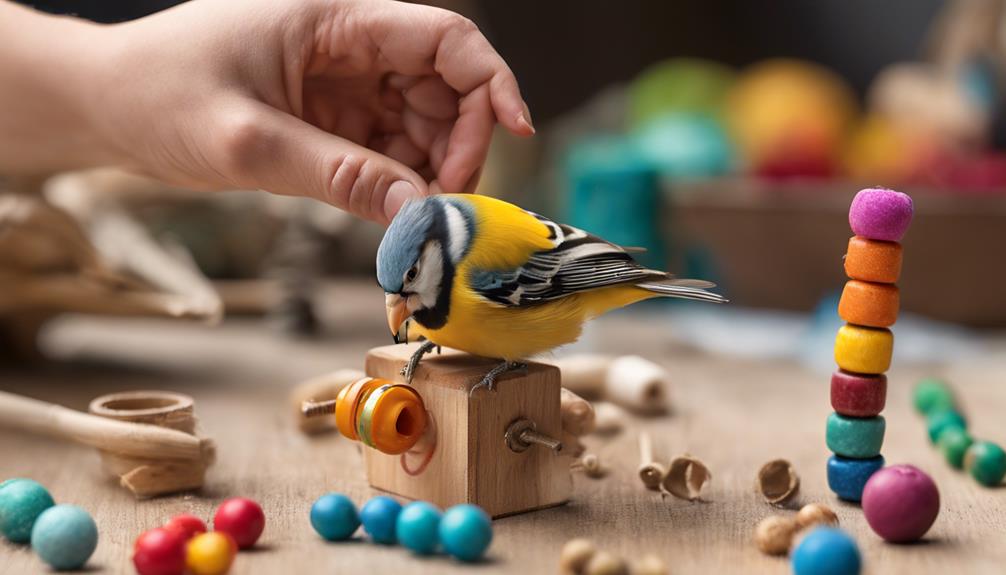
To assemble your homemade foraging toy, begin by choosing the right materials like paper plates and cardboard pieces. Utilize assembly techniques such as creating compartments with egg cartons for added complexity.
Follow these steps to guarantee a stimulating and safe foraging experience for your feathered companions.
Toy Material Selection
Consider carefully selecting materials for homemade foraging toys to guarantee the safety and enjoyment of your bird companion. Opt for safe and bird-friendly options like untreated wood, paper, cardboard, and natural fibers. These materials are non-toxic and won't harm your bird if ingested.
Avoid toxic paints, glues, plastics, or small parts that could be swallowed and pose a choking hazard. Choose items that can be easily manipulated by birds, such as shreddable paper, foraging cups, or compartments for hiding treats.
Incorporating a variety of textures and colors will engage your bird's senses and simulate their natural foraging experiences in the wild. Additionally, provide a mix of challenges and interactive elements in the toy design to keep your feathered friend mentally stimulated and physically active during playtime.
Assembly Techniques
Begin by selecting a sturdy base, such as a paper plate or plastic serving tray, for your homemade foraging toy. Cut up plain white paper or crinkle paper into small pieces to fill the base, creating a textured surface for your bird to forage through.
Next, add a variety of items like paper straws, cardboard pieces, cork buttons, and natural materials to keep your feathered friend engaged and entertained. Incorporate challenges by hiding treats or seeds in different compartments, like using an egg carton tray with multiple sections for added complexity.
Remember to prioritize the safety of your bird by ensuring all materials used are bird-friendly and non-toxic. By following these assembly techniques, you can create a stimulating and enjoyable foraging experience for your pet bird while promoting their natural instincts and mental stimulation.
Tips for Introducing Toys to Birds

When introducing toys to your bird, remember to start slow to avoid overwhelming them. Choose toys that are suitable for your bird's size, species, and personality for a positive play experience.
Toy Selection Tips
To successfully introduce toys to your bird, start by gradually presenting them one at a time to prevent overwhelming your feathered friend. This approach allows your bird to adjust to each new toy and prevents stress. Rotate toys regularly to keep your bird engaged and interested, as this prevents boredom and encourages exploration.
Offering a variety of textures, colors, and shapes stimulates your bird's senses, providing mental and physical enrichment. Monitoring your bird's interactions with toys is essential to guarantee safety and enjoyment. Pay attention to how your bird plays with each toy and remove any damaged or potentially hazardous items promptly.
When selecting new toys, consider your bird's preferences and behavior. Different birds have varying interests, so observe what types of toys your bird enjoys the most. Tailoring toy selection to your bird's preferences can increase engagement and playtime.
Encouraging Play Behavior
To guarantee the safety of your bird, introducing toys gradually can help them feel more comfortable and engaged with their new playthings. To promote play behavior, use positive reinforcement such as treats or praise when your bird interacts with and explores the toys. It is crucial to rotate toys regularly to prevent boredom and keep your bird mentally stimulated. Observing your bird's preferences and play style will help you select toys that cater to their interests and needs. Always make sure that the toys you provide are safe, durable, and appropriate for your bird's species and size to avoid accidents or ingestion of harmful materials.
| Tips for Encouraging Play Behavior |
|---|
| 1. Introduce toys gradually to avoid overwhelming your bird. |
| 2. Use positive reinforcement like treats or praise. |
| 3. Rotate toys regularly to keep your bird engaged. |
| 4. Observe your bird's preferences and play style. |
| 5. Make sure toys are safe, durable, and suitable for your bird. |
Safety Considerations for Homemade Toys
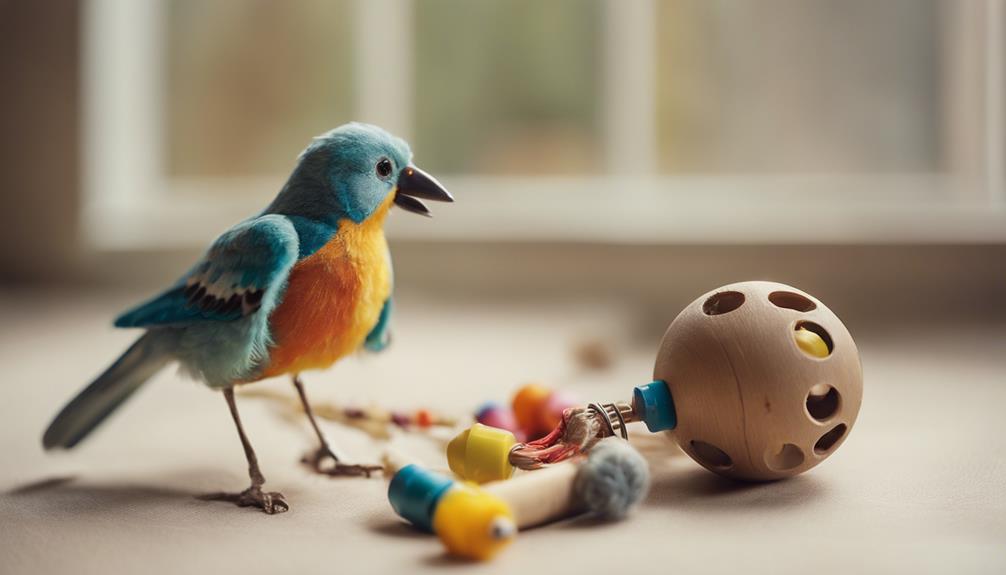
Make sure that homemade bird toys are free from potential choking hazards, toxic materials, and securely attached components to prioritize your bird's safety during playtime. Check for any small parts or loose strings that could pose a choking risk.
Toxic materials like glue, paint, or certain types of wood should be avoided to prevent harm if ingested. Confirm all toy components are firmly attached to prevent accidental ingestion or entanglement.
It's important to monitor your bird while they play with homemade toys to ensure they're using them safely. Regularly inspect these toys for wear and tear, replacing them if they become damaged to prevent any potential injuries.
Enhancing Foraging Experience With Variations

Enhance your bird's foraging experience by incorporating a variety of materials and challenges into their foraging trays. Customizing these trays with a mix of paper straws, cardboard pieces, and lolly sticks allows you to cater to your bird's individual preferences.
By adding natural elements like dried grasses, mahogany pods, and corn halves, you can create a more engaging foraging experience that mimics the wild.
For a mental challenge, utilize complex foraging trays with compartments such as egg cartons to keep your bird entertained and stimulated during foraging sessions.
Expert foragers may benefit from the inclusion of broken toy parts, finger traps, and rat handballs in their trays, providing interactive and challenging activities.
To keep things visually interesting, enhance your bird's foraging trays with colorful and multifaceted designs, including grooves for eggs, ensuring a continuous level of engagement throughout the foraging process.
Frequently Asked Questions
What Are the Home Made Bird Foraging Toys?
Home made bird foraging toys are DIY creations that stimulate your bird's natural instincts. You can craft these toys from everyday materials like paper, cardboard, and straws to provide mental and physical enrichment, tailored to your bird's preferences.
Why Do Birds Need Foraging Toys?
Birds need foraging toys as they provide mental stimulation, prevent boredom, and replicate natural foraging behaviors. These toys improve problem-solving skills, physical activity, and overall well-being, reducing stress and preventing behavioral issues in pet birds.
Can a Bird Cage Have Too Many Toys?
You can overcrowd a bird cage with too many toys, limiting your bird's freedom of movement. Provide a variety of safe toys for mental stimulation but avoid overwhelming them. Rotate toys to keep your bird engaged and monitor their behavior.
What Household Items Can Birds Play With?
You can jazz up your bird's playtime with simple household items like paper cups, paper towel rolls, and cardboard boxes. These inexpensive options offer mental stimulation and entertainment, keeping your feathered friend happy and engaged.
Conclusion
To sum up, homemade foraging toys aren't only a fun and engaging way to keep your bird entertained, but they also provide important mental and physical stimulation.
By using a variety of materials and designs, you can create a stimulating environment for your feathered friend.
Remember to prioritize safety and introduce toys gradually to guarantee a positive experience.
So get crafting and watch your bird soar with excitement as they explore their new toys!
-

 Foraging Basics2 months ago
Foraging Basics2 months agoAdd a Forage Certificate to Your LinkedIn Profile and Level Up Your Career
-

 Edible Wild Plants2 months ago
Edible Wild Plants2 months agoUnbelievable Power: The World's Most Formidable Forage Harvester
-

 Foraging Basics2 months ago
Foraging Basics2 months agoForage the City: Your Guide to Successful Urban Foraging
-

 Foraging Basics2 months ago
Foraging Basics2 months agoThe Shocking Truth About Foraging (That Experts Don’t Want You to Find Out)
-

 Foraging Basics2 months ago
Foraging Basics2 months agoThe Resume Hack That Will Make Your Foraging Experience Stand Out
-

 Recipes and Preparation2 months ago
Recipes and Preparation2 months agoThe #1 Sought-After Forage That's Transforming Livestock Nutrition
-

 Recipes and Preparation2 months ago
Recipes and Preparation2 months agoThe One Wild Edible That Will Transform Your Cooking (And It’s Free!)
-

 Foraging Basics2 months ago
Foraging Basics2 months agoDiscover the Largest Forage Wagon in the World!














